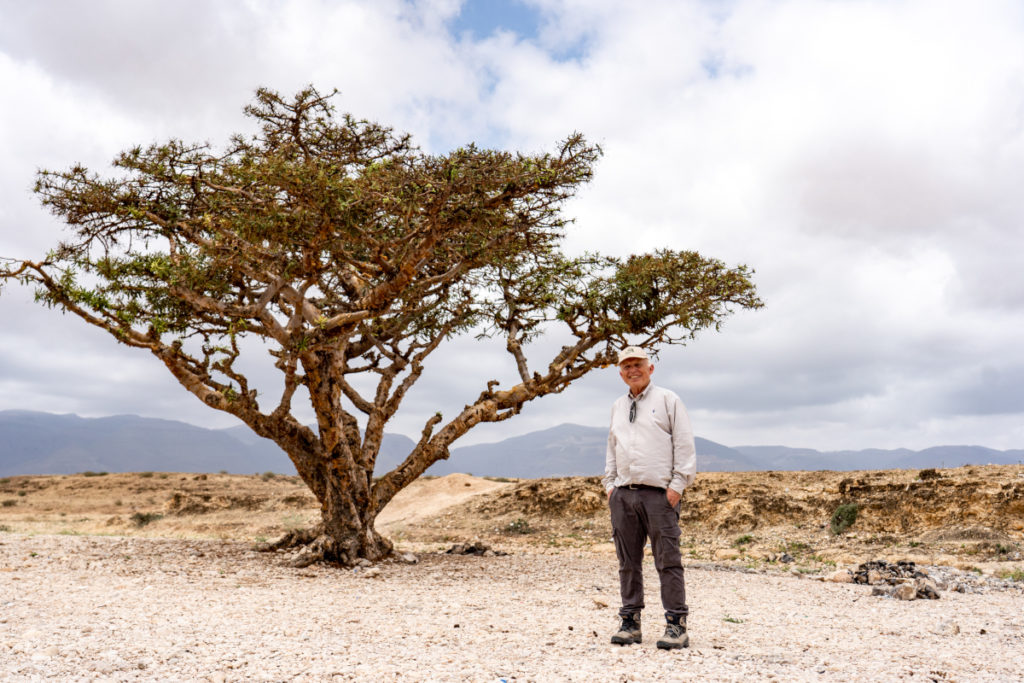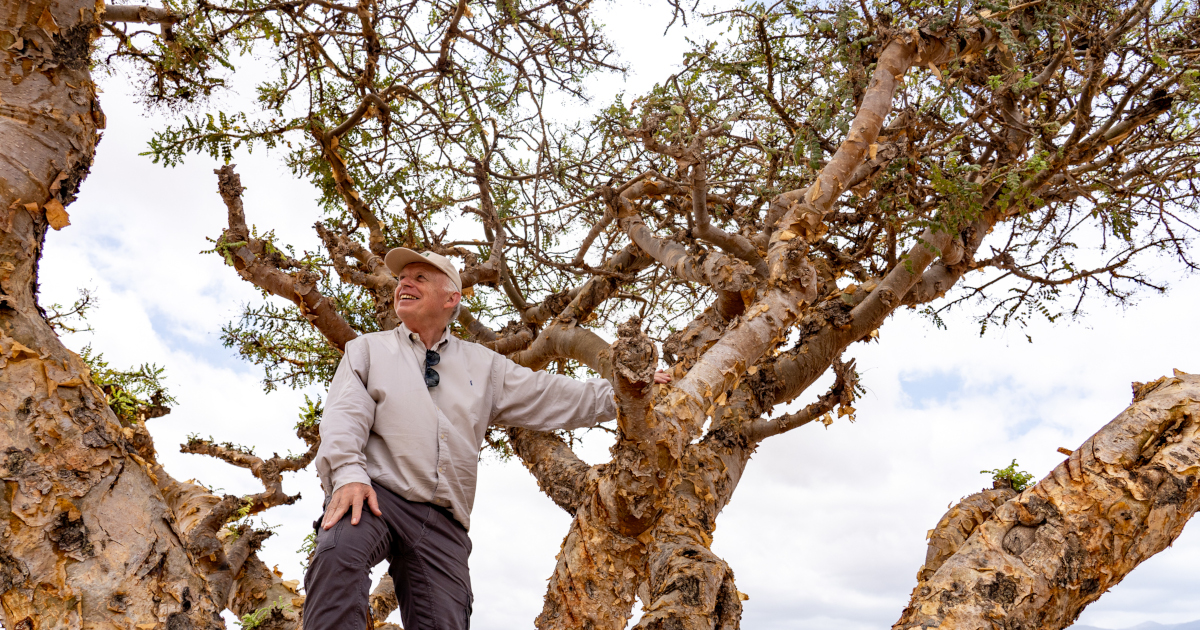Cette publication est également disponible en :
Français
Editorial partnership
After 30 years of experience in sourcing natural products, Dominique Roques has been given a three-year mission by Amouage. He is tasked with plotting the renaissance of the frankincense industry in the Wadi Dawkah natural park in the Sultanate of Oman, a UNESCO World Heritage Site. Why him? Because rekindling a tradition spanning several millennia requires an expert, someone with humility, curiosity and enthusiasm. He talks to us about the project. Interview.
In early 2023, you set up your consultancy, Balsam Consulting, after having worked at Biolandes, then Firmenich [now DSM-Firmenich]. Renaud Salmon, Chief Creative Officer at Amouage, got in touch with you shortly thereafter to ask you to help the house set up the Wadi Dawkah project. What was it about this new adventure that appealed to you?
What I’m really passionate about are perfume trees. I wrote a book that explored the subject extensively (In Search of Perfumes, HarperVia, 2023), then another that delved into it even further (Le Parfum des forêts, Grasset, 2023). Working on a multifaceted project focusing on frankincense trees is a wonderful opportunity for me, especially as this particular tree is rather hard to understand. Why is it different on the two shores of the Gulf of Aden? Do frankincense trees only grow at high altitude? Do we find them at sea level? What are the right techniques for tree tapping – a process that consists in making an incision in the tree trunk so that it will secrete resin? Can we create plantations of frankincense trees? Would the quality of the resin be the same? I’m fascinated by all these questions, so I immediately said yes to the chance of making my modest contribution to the project.
I imagine that acquiring a comprehensive understanding of the frankincense tree is not something you can do alone. Whom do you work with?
There’s a very practical side to the Wadi Dawkah project: We have three years to set it up. In Salalah, the nearest town to the UNESCO-listed site in the south of Oman, Amouage hired Matthew Wright to spearhead the project. We explore all these questions together. We try to be realistic in terms of asking ourselves what we really know and what we don’t. This is not a field with a large pool of international experts. It means we have to merge academic data with traditional knowledge so we can make slow, steady progress.
What is the average age of a frankincense tree?
We don’t know! If we know when it was planted we can watch it develop. But there are trees in Wadi Dawkah that seem to have always been part of the landscape. They are old and big, never very tall because they don’t grow above 7 meters. I’ve talked to a lot of people and, almost unbelievably, no one seems to know. And that’s brilliant! Let’s say somewhere between 50 and 150 years for the biggest trees in Wadi Dawkah.
In terms of productivity, does the amount of resin produced by a tree vary over time?
The secret to tapping is to spread out the areas where you cut the tree so that the incisions are far enough apart to avoid overexploiting it. The taller and bigger the tree, the greater the bark surface it has for making new incisions, meaning it supplies more resin than a young tree. This phenomenon is all the more marvelous when you remember that the frankincense tree never stops producing resin throughout its life. The same applies to other perfume trees in different parts of the world, like the Peru balsam tree and styrax. Once the communities that learned to live alongside these trees worked out the best methods for exploiting them, the trees give the impression that they have incorporated tapping into their life cycle.

© Amouage
But the frankincense tree is endangered in Oman. Why is that?
It faces two main threats. The first, and the one I feel is the most dramatic, is camels. They eat everything in the desert, and as soon as a frankincense tree starts to produce young shoots, the animals devour them. And that’s terrible. Terrible. Terrible. Frankincense trees will have no chance of flourishing in Oman outside areas where we manage to keep camels away. It’s an interesting and delicate subject since it reflects social changes taking place in the country. Traditionally, camel grazing was linked to a complex division of land and trees established between Omani tribes and clans. Once tree territories were settled, owners made sure their camels did not wander. This custom has changed a lot over recent decades as the country has developed.
The second problem relates to the pressure urban growth places on wilderness areas. But the existence of the Wadi Dawkah project has led to the implementation of a program for protecting and transplanting trees, encouraging the creation of a frankincense industry.
So, can frankincense trees be transplanted successfully?
In general, the older the trees, the more developed they are and the more complicated it becomes to transplant them. But how these types of trees respond to being moved varies a lot depending on the species. Around ten years ago, for example, we realized that it isn’t much of a problem for olive trees. I’m staying cautious because you need to be very objective, but it seems to me that the frankincense tree has something in common with the olive tree. We could call it resilience or adaptability. For example, we work with companies, encouraging them to save trees and transplant them before they strip hilltops to extract material for making lime. In Wadi Dawkah, we need to supplement the existing population with trees from outside because when there are more trees there’s a greater tapping capacity. Safeguarding the trees is a real ecological challenge, as well as an opportunity to take things a little further and faster at a time when we’re trying to create a true frankincense production industry.
How does the frankincense tree survive?
It flourishes in the deserts and mountains of Oman, which is pretty amazing. There’s water during the monsoon season, then no water for months on end, but it survives and adapts. On the other hand, we know very little about the frankincense tree’s water and irrigation
needs. For example, a large number of saplings were planted ten years ago in Wadi Dawkah and they were clearly over-irrigated; the trees didn’t thrive. They didn’t grow well, and we are having to remedy the situation. What we need to do is start over again, with patience and open minds – we’re feeling our way.
How does the Wadi Dawkah project differ from what you were doing before?
I used to focus on supply chains with clients who were looking for specific products and quantities. Here, we’re looking at a totally hybrid project: We want to create a real production sector with 15,000 trees eventually, and link it to a tourist center that will be nothing like Disneyland! This involves working on developing a unique, aesthetically pleasing tourist site and creating a museum-type experience while ensuring the site cohabits with a supply chain that has been devised, set up and developed to be visible to everyone. It really is a rare situation for perfume plants, and I love the idea of working toward both goals at once.
In your writing, we get a strong sense of the importance of the people behind perfume plants. What is the human element here?
Frankincense is culturally very important for the Omani community. And I hope, from the bottom of my heart, that this project at Wadi Dawkah will live up to its goal of helping to bring about the renaissance of a whole industry, a possible model for future tapping in the mountains of the Dhofar Governorate. Because if Oman wants to be able to take pride in its frankincense, the entire process must be transparent, ethical and meet every requirement that applies to harvesting wild products for perfumes: no overexploited trees, decent wages for the people making a living from the trees, etc. And as far as I’m concerned, there’s no reason to think that won’t be possible.
Visuals: © Amouage
TABLE OF CONTENTS OF OUR MAIN FEATURE “WADI DAWKAH“
- A panorama of the Land of Frankincense
- Frankincense, Oman’s essence
- Olibanum resin: a panacea?
- Eating Frankincense
- The quintessential scents of Oman
- The Incense Trade Route, by Sterenn Le Maguer-Gillon
- Perfume as a way of life in the Middle East
- Wadi Dawkah, The Land of Frankincense (Podcast)
- Oman, strategically positioned in the Gulf
- Sayyid Khalid: “Wadi Dawkah was chosen to reintroduce frankincense globally”
- Renaud Salmon: “Wadi Dawkah is serving as a pilot project for the Omani frankincense industry”
- Dominique Roques: “Working on a multifaceted project focusing on frankincense trees is a wonderful opportunity”








Comments